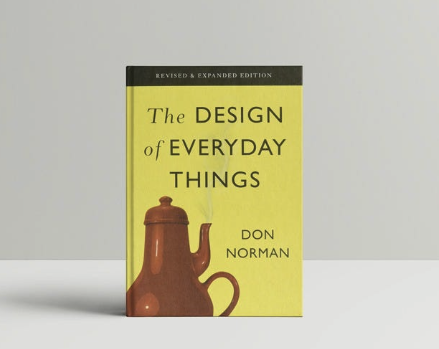My toxic trait is that I believe anybody who builds anything should be required to read this book pic.twitter.com/XgRGrSw6Pk
— Jake (@JustJake) May 28, 2025
- Affordances: Objects should visually suggest how they can be used. For example, a door handle should imply pulling, while a flat plate suggests pushing. Affordances are the possible actions a user perceives based on an object’s design. When affordances are unclear (e.g., a door with no visible handle), users struggle.
- Signifiers: These are cues that communicate how to use an object. A well-placed arrow or label on a button is a signifier, guiding the user to the correct action. Good signifiers make affordances obvious, reducing confusion.
- Feedback: Users need immediate, clear feedback to know if their actions worked. For instance, a light turning on when a switch is flipped confirms the action. Without feedback, users are left guessing, leading to errors.
- Discoverability: A good design allows users to figure out what actions are possible and how to perform them. This depends on clear affordances, signifiers, and feedback working together.
- Conceptual Models: Users form mental models of how things work based on their interactions. Good design aligns an object’s appearance and behavior with the user’s expectations, making the system predictable and easy to understand.
- Constraints: Designs should limit incorrect actions. Physical constraints (e.g., a USB plug that only fits one way) or cultural constraints (e.g., red for “stop”) guide users toward correct usage.
- Mapping: The relationship between controls and their outcomes should feel natural. For example, turning a steering wheel right should make a car turn right. Poor mapping, like a stove with knobs that don’t clearly correspond to burners, causes confusion.
- Forming a goal (e.g., “I want coffee”).
- Planning (e.g., “I’ll use the coffee machine”).
- Specifying an action (e.g., “Press the brew button”).
- Performing the action (e.g., pressing the button).
- Perceiving the outcome (e.g., seeing coffee pour).
- Interpreting the outcome (e.g., “The machine is working”).
- Comparing the outcome to the goal (e.g., “I got my coffee”).
- Observe users in real-world settings to understand their needs and behaviors.
- Iterate designs based on testing and feedback.
- Simplify interfaces to reduce cognitive load.
- Standardize where possible to leverage familiar patterns (e.g., consistent icons across apps).
The Design Of Everyday Things https://t.co/jOYWar5ozL
— Paramendra Kumar Bhagat (@paramendra) May 29, 2025
It is as awesome as you said. Mind blowing.
— Paramendra Kumar Bhagat (@paramendra) June 4, 2025
— sarah guo // conviction (@saranormous) June 3, 2025
This is a brilliant piece of writing. I will let you invest in my startup. https://t.co/ZCi1DP8SSD
— Paramendra Kumar Bhagat (@paramendra) June 4, 2025
- Sarah Guo’s article defines taste as a competitive advantage in software, emphasizing intentional design in products like Stripe’s plain-English error messages and Spotify’s engineered shuffle algorithm.
- Taste goes beyond aesthetics, involving deep decisions in codebases, culture, and even cap tables, akin to a chef’s palate in crafting a Michelin-star meal.
- True taste requires sacrifice, such as rejecting features that don’t align with a product’s vision, even if they could expand market reach.
- In the AI era, taste enables sustainable speed by providing clarity in decision-making, reducing revisions and pivots.
- Companies with taste, like Linear and Figma, create products that feel inevitable, building trust and commanding premium pricing through coherence.
- Taste in go-to-market strategies ensures a unified voice across all customer touchpoints, from sales decks to support docs, enhancing perceived reliability.
- Early sales hires must embody the company’s taste, turning away wrong-fit customers and demoing the product’s philosophy, not just its features.
- Taste doesn’t scale automatically—it requires systems like founder oversight, hiring multipliers (e.g., designers who code), and tracking “delight debt” alongside technical debt.
- Taste-driven companies often remain founder-led longer to transmit judgment through apprenticeship, as taste is absorbed, not taught.
- While taste offers a compound advantage in competitive markets, companies like Salesforce show that solving critical problems can trump design in some industries.
Sarah Guo’s (@saranormous) article defines taste as a competitive advantage in software, emphasizing intentional design in products like Stripe’s plain-English error messages and Spotify’s engineered shuffle algorithm. 🧵👇
— Paramendra Kumar Bhagat (@paramendra) June 4, 2025

